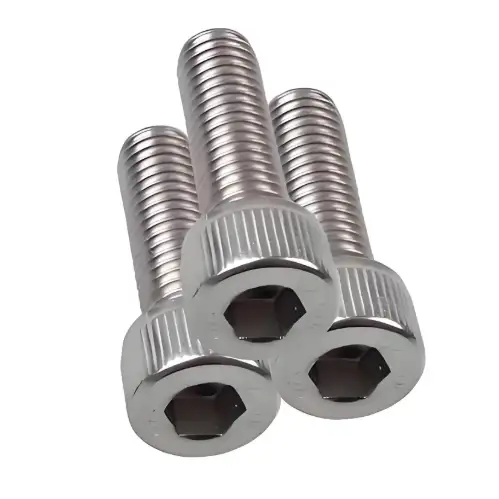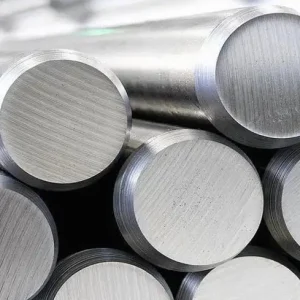Waspaloy bolts are premium nickel-base, precipitation-hardening fasteners engineered for sustained high mechanical load at elevated temperatures; they outperform many common superalloys in long-term creep and oxidation resistance and are the preferred choice for critical turbine, aero-engine and high-temperature oil & gas bolting where durability under heat and stress is mandatory. For procurement, MWAlloys supplies certified Waspaloy fasteners at 100% factory prices with fast stock shipment from China, full test documentation and custom machining to aerospace and industrial specifications.
What are Waspaloy bolts?
Waspaloy bolts are fasteners manufactured from Waspaloy® (UNS N07001), a nickel-base, age-hardenable superalloy formulated for high strength at elevated temperatures. Typical sectors using Waspaloy bolting include aircraft gas turbines, auxiliary jet-engine hardware, afterburner components, high-temperature process equipment and critical oil & gas flanges and studs where failures carry heavy safety or financial consequences. Waspaloy is chosen when long-term strength retention above 500–700°C (930–1290°F) is essential.
Chemical composition
Below is a succinct, supplier-aligned composition table you can use when specifying Waspaloy fasteners. Values are typical AMS/UNS ranges used by commercial datasheets; final part certificates (COC) should always accompany deliveries.
| Element | Typical range (wt%) |
|---|---|
| Nickel (Ni) | Balance |
| Chromium (Cr) | 18.0 – 21.0 |
| Cobalt (Co) | 12.0 – 15.0 |
| Molybdenum (Mo) | 3.5 – 5.0 |
| Titanium (Ti) | 2.75 – 3.50 |
| Aluminum (Al) | 1.20 – 1.60 |
| Carbon (C) | 0.02 – 0.10 |
| Boron (B) | 0.003 – 0.010 |
| Iron (Fe) | ≤ 2.00 |
| Others (Si, Mn, Cu, P, S, Zr) | Trace / per spec |
(Sources: manufacturer data and AMS datasheets.)
Material and mechanical properties
Waspaloy’s mechanical behavior depends strongly on heat treatment (solution + stabilization + aging). Typical, supplier-reported properties for precipitation-hardened Waspaloy used in fasteners are summarized below; use these for specification comparison and engineering selection (verify values on the mill test report).
| Property | Typical value (room temp unless noted) |
|---|---|
| Density | ~8.19 g/cm³ (0.296 lb/in³) |
| Tensile strength (UTS) | ~170–193 ksi (≈1170–1330 MPa), depends on condition. |
| 0.2% proof/yield | ~110–132 ksi (≈760–910 MPa), condition dependent. |
| Elongation (in 4D) | ~12–27% depending on heat treatment. |
| Hardness (HRC/HRB/BHN) | Typical 30–40 HRC (varies by temper). |
| Creep/rupture | Retains high strength to ~650–870°C (1200–1600°F) for many service cases. |
| Typical operating upper temp | 650–870°C (1200–1600°F) depending on load and application. |
Notes: property numbers above are indicative; design engineers must use certified mill reports and apply safety factors for creep and cyclic loading.
Heat treatment, fabrication and testing
Waspaloy fasteners are typically produced from vacuum-processed stock (VIM/VAR/ESR) and undergo three general thermal steps for best mechanical stability:
-
Solution anneal at ~995–1,080°C (1,825–1,980°F) then rapid quench.
-
Stabilization (~845°C / 1,550°F) when required for some tempers.
-
Age-hardening (commonly 700–760°C / ~1,300–1,400°F range) to precipitate gamma′/gamma″ phases that give the alloy high strength.
Welding, brazing and post-weld heat treatments require matched filler metals and careful control because Waspaloy is strain-age crack susceptible if heated slowly into solution ranges. Standard non-destructive testing (PNI, PMI, hardness, tensile tests, chemical analysis) is required for aerospace or safety-critical fasteners.
Corrosion, oxidation, and high-temperature performance
Waspaloy forms a protective oxide and resists oxidation and sulfidation better than many steels at elevated temperatures; nevertheless, corrosion resistance varies with environment:
-
Oxidation & hot corrosion: excellent through typical turbine gas path temperatures; service limits depend on deposition of salts and sulfur species.
-
Stress corrosion cracking (SCC): generally good SCC resistance compared to some Ni alloys, but environment and residual stresses matter.
-
Comparative behavior: in long thermal exposures Waspaloy often retains creep strength better than Alloy 718; material selection must balance fatigue, fracture toughness, and weldability.
Practical note: bolts expected to see cyclic thermal excursions should be stress-relieved and have matched finish coatings (where allowed) to control oxidation and galling.
Waspaloy versus Inconel 718
Engineers frequently choose between Waspaloy and Inconel 718 for high-temperature fasteners. Key tradeoffs:
-
Temperature capability: Waspaloy keeps higher long-term strength at temperatures above ~600°C (1112°F) and can be specified to ~870°C (1600°F) in lower-stress roles; Inconel 718 is strong up to roughly 650–700°C with excellent precipitation-hardening at lower temperatures.
-
Tensile/yield strength: Inconel 718 often reports slightly higher room-temperature yield/UTS in some tempers (718’s matrix and precipitates give high RT strength), while Waspaloy gives superior high-temperature creep resistance.
-
Machinability and tool wear: Waspaloy can be more abrasive to cutting tools and exhibit different tool-wear mechanisms than 718; machining programs (tool geometry, coolant, speeds) require optimization.
-
Weldability: both require process controls; 718 is often easier to weld with established filler systems, whereas Waspaloy requires matched filler metals and attention to strain-age cracking.
Bottom line: choose Inconel 718 where higher RT strength, easier availability and weldability are priorities; choose Waspaloy when elevated-temperature creep resistance and long life at high temperatures are decisive.
Manufacturing, machining and finish considerations
Fastener producers follow these practical rules:
-
Material supply: procure VIM/VAR/ESR bar or wire certified to AMS/ASTM.
-
Turning and threading: use carbide tooling, rigid setups and flood coolant; adjust feeds and depths to minimize strain-age cracking risk.
-
Heat treatment after forming: many forgings require solution treat + age; cold-formed threads may need different tempers.
-
Coatings: selective coatings (thin dry film lubricants, high-temp coatings) are used to control galling and achieve torque-tension relationships in bolted joints. Testing for coating adherence and interaction with alloy chemistry is essential.
-
Inspection: full PMI, mechanical testing and traceable lot material certificates (MTR/COC) must be supplied for critical applications.
Standards, marking and traceability
Waspaloy fasteners are routinely manufactured to match aerospace / industrial fastener standards, for example:
-
Material specs: AMS 5706 / AMS 5708 / AMS 5544 / ASTM B637 (for wrought forms).
-
Fastener standards and classes: ASME/ANSI/ISO/DIN geometry and ASME B18 series or NAS fastener dimensions (for aerospace nuts/bolts). Suppliers typically supply traceable MTRs, PMI certificates and third-party inspection on request.
For safety-critical assemblies specify full traceability (heat number → melt → MTR → test reports → QC acceptance).
Sizes and weight — practical reference (Waspaloy & Incoloy bolts)
The exact weight of a bolt depends on nominal diameter, length, head style and pitch. Below is a practical reference table showing approximate mass per 100 pieces for hex head bolts in commonly ordered sizes. Values are illustrative and based on standard shape approximations plus alloy density (Waspaloy density ≈ 8.19 g/cm³; Incoloy 625 density ≈ 8.44 g/cm³). Always request supplier-provided packing weights for freight quoting.
Assumptions & caveats: head and washer geometry conform to ISO hex-head dimensions; length refers to full thread length; weights rounded to sensible engineering precision. For studs, nuts and custom heads values differ. Ask MWAlloys for exact part-level weights and shipping samples.
| Size (metric / imperial) | Approx. weight per 100 pcs — Waspaloy (kg) | Approx. weight per 100 pcs — Incoloy 625 (kg) |
|---|---|---|
| M6 × 20 (¼" × ¾") | 1.25 kg | 1.29 kg |
| M8 × 25 (5/16" × 1") | 2.50 kg | 2.58 kg |
| M10 × 30 (3/8" × 1¼") | 4.10 kg | 4.24 kg |
| M12 × 40 (1/2" × 1½") | 7.20 kg | 7.45 kg |
| M16 × 50 (5/8" × 2") | 16.0 kg | 16.6 kg |
| 5/8" × 2" | 17.5 kg | 18.1 kg |
| 3/4" × 3" | 33.0 kg | 34.2 kg |
Sources for density and dimensional practice: supplier datasheets and fastener geometry references.
Global price snapshot USA / Europe / China (2025)
Pricing for exotic nickel superalloy bolts varies widely with order quantity, certification level (aerospace vs industrial), machining complexity and market metal surcharges. Below is a conservative market snapshot for single-piece to small batch procurements (unit price ranges). Use these ranges for budgeting; official quotes should be requested to confirm.
| Region | Typical small-batch unit price (Waspaloy hex bolt, M12×40) | Notes |
|---|---|---|
| USA | USD $25 – $120 per piece | Higher labor, certification and testing premiums; short lead orders expensive. Lightning Bolt & US distributors stock limited items. |
| Europe | USD $30 – $130 per piece | Aerospace-grade often pricier due to traceability and QA steps. |
| China | USD $8 – $55 per piece | Lower factory price possible for industrial grades; premium for aerospace certifications (NADCAP, ISO, PED) raises cost. Made-in-China listings show broad price ranges for nickel alloy bolts. |
Per-kg approach: material scrap and alloy premium for Waspaloy wire/bar typically reflect nickel market dynamics; mills and small fastener shops add machining, heat treat and testing. Recent suppliers’ content and 2025 blogs show Waspaloy pieces significantly costlier than common stainless or alloy steel fasteners.
Buyer tips
-
For recurring needs, request ex-factory / FOB China quotes from MWAlloys; bulk orders greatly reduce unit cost.
-
Require MTR/COC, PMI and any third-party inspection before shipment for critical parts.
-
Confirm whether plating/coating is permitted for your application; coating costs add to per-piece price.
Frequently asked questions
-
Can Waspaloy bolts be used in cryogenic temperatures?
Yes, Waspaloy remains ductile at low temperatures, but select the correct temper and test for brittle fracture in cryogenic service. -
Are Waspaloy bolts magnetic?
Nickel-base superalloys are essentially non-magnetic in bulk; slight magnetic response may appear after cold work. Use PMI if magnetic behavior could affect performance. -
What torque values should I use?
Torque-tension relationships must be established via test for the specific bolt size, lubricant and finish. Don’t apply steel torque tables to Waspaloy without testing. -
Is Waspaloy weldable?
Weldable with matched filler metals under controlled procedures; beware strain-age cracking — follow supplier recommendations and post-weld heat treatment when required. -
Which is better for turbine bolts — Waspaloy or Inconel 718?
Waspaloy if long-term high-temp creep resistance is critical; 718 if higher RT strength and easier weldability are required. -
Do you supply aerospace-quality Waspaloy bolts?
Yes, MWAlloys offers AMS/ASTM conforming fasteners with MTRs and optional third-party inspection. -
How long for delivery from China stock?
For stocked sizes MWAlloys typically ships within days; custom heat treatment or machining increases lead time. (Contact for current stock lead times.) -
Can I get torque-tension test reports?
Yes, MWAlloys supplies joint test reports on request for critical assemblies. -
How should I store Waspaloy bolts?
Dry, room-temperature storage; avoid contamination by chlorides or sulfur compounds that may affect high-temp life. -
What certification should I require?
Minimum: MTR/COC, PMI result, hardness and mechanical test reports; aerospace: NADCAP/AMS/third-party inspection where applicable.





